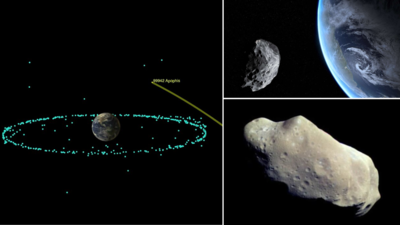India’s space agency, the Indian Space Research Organisation (ISRO), is grappling with a significant challenge as it evaluates the potential threat posed by the asteroid Apophis. This massive space rock, named after the ancient Egyptian deity of chaos, presents a notable concern due to its size and trajectory.
Apophis, measuring approximately 370 meters in diameter, surpasses the length of India’s largest aircraft carrier, INS Vikramaditya, and is larger than the Narendra Modi Stadium, the world’s largest cricket venue. The asteroid’s potential to come close to Earth has placed it on the radar of global space agencies, including ISRO.
Initially discovered in 2004, Apophis garnered attention due to its predicted close encounters with Earth in the coming decades. While early calculations suggested a higher likelihood of collision, subsequent observations have revised these probabilities. However, its close approach in 2029 will bring it within 31,000 kilometers of Earth, a distance closer than some geostationary satellites.
ISRO has been actively monitoring Apophis’s trajectory using advanced telescopic systems and computational models. The agency’s primary goal is to refine its impact probability assessments and develop potential mitigation strategies if necessary. This includes collaboration with international space agencies and scientists to improve predictive models and enhance tracking capabilities.
The asteroid’s approach presents a unique set of challenges for ISRO. Unlike smaller asteroids, which may burn up in the Earth’s atmosphere or pose minimal risk, Apophis is large enough to cause significant damage should it collide with Earth. The focus now is on precise calculations to determine the exact risk level and potential impact on Earth’s surface.
The collaboration between ISRO and other space agencies is crucial in addressing the threat posed by Apophis. The European Space Agency (ESA) and NASA have already undertaken similar initiatives to track and study potentially hazardous asteroids. Their experiences and data are instrumental in shaping ISRO’s approach to this challenge.
The research into asteroid deflection techniques also plays a significant role in ISRO’s strategy. Methods such as kinetic impactors, which involve sending a spacecraft to collide with the asteroid to alter its course, are under consideration. Additionally, gravitational tractors, which involve using the gravitational pull of a spacecraft to slowly change the asteroid’s trajectory, are being explored.
Apophis’s large size means that even minor deviations in its path could result in substantial shifts in its predicted trajectory. This makes it critical for ISRO to continuously update and verify its impact models. The agency is also focusing on public awareness and preparedness, ensuring that potential risks are communicated effectively to mitigate any undue panic.
The international space community’s response to Apophis highlights a growing recognition of the need for global cooperation in planetary defense. As asteroid tracking technology improves and our understanding of these celestial bodies advances, the strategies to address potential threats are becoming more sophisticated.
ISRO’s role in planetary defense extends beyond just tracking and monitoring. The agency is also involved in research on impact mitigation and disaster management strategies. The knowledge gained from studying asteroids like Apophis contributes to broader scientific knowledge and enhances our preparedness for future cosmic threats.
As the 2029 close approach of Apophis approaches, ISRO’s ongoing research and international collaborations will be vital in determining the best course of action. The agency’s efforts in refining its impact predictions and developing potential mitigation strategies reflect a proactive approach to dealing with space hazards.
The potential impact of Apophis underscores the importance of continued investment in space science and technology. The advancements in tracking, predictive modeling, and impact mitigation techniques are critical in ensuring that humanity is prepared for potential space threats.




 Supreme Court Orders Striking Doctors to Resume Duties
Supreme Court Orders Striking Doctors to Resume Duties 